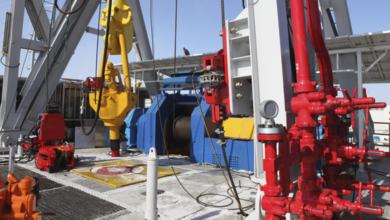Drilling & Completion Tech Digest
Bi-fuel conversion system subs out 50%-plus diesel in barnett field tests

Recent testing in the Texas Barnett Shale where GFS Corp installed its bi-fuel conversion EVO-SP System on drilling rig generator sets has yielded a diesel substitution rate in excess of 50%.
The system, which was installed on a 1,250 kWe Caterpillar 3512C engine, incorporates dynamic set point protection that maps critical set points continuously across the entire load range of the engine.
Compared with systems that map critical pre-alarm and shut-down set points only at maximum load or at a few selected load profiles, this continuous mapping safely allows for maximum gas substitution rates.
This is accomplished by monitoring mass air flow using the company’s mass air flow sensor technology, which is patent pending. This allows the system to anticipate load changes instead of reacting after the event has taken place.
The system also incorporates a touchscreen display with a graphical user interface, an engine control unit that monitors and responds to key engine sensors every 50 milliseconds, air/gas mixers with integrated throttle bodies, pre-assembled gas trains and plug-and-play wiring harnesses.
Testing showed that the new bi-fuel system (natural gas and diesel) can save the operator $30,000 to $40,000 per 19-day drilling cycle, according to the company.
Chevron installs new riser monitoring system in UK
Chevron has deployed a new integrity monitoring technology in the Captain field in the UK North Sea. Flexlife’s FlexGuard, a detection system for riser integrity issues, provides continuous real-time data on the condition of flexible risers.
“Data produced showed that the annulus was not flooded where the FlexGuard module was installed, which could cause corrosion of the riser’s structural steel wires,” Luke Wilkinson, project manager and principal engineer at Flexlife, said.
Gas from producing well used to power frac operation
FTS International and Cabot Oil & Gas have partnered to use natural gas from a producing gas well to power pressure-pumping equipment for a fracturing treatment. This marks the first time field gas has been used in northeastern Pennsylvania for this purpose, according to the companies.
The fracturing work was completed in the Marcellus Shale and was part of a “zipper” completion that included 57 fracturing stages. The zipper work involved alternating fracture stimulations between three offset wells with wellheads on the same pad.
Chevron completes 3 wells in deepwater GOM with single-trip, multizone system

Chevron has completed three wells in the Lower Tertiary in deepwater Gulf of Mexico (GOM) using Halliburton’s Enhanced Single-Trip Multizone (ESTMZ) FracPac system. The two companies jointly developed the technology and have conducted numerous integration tests and two field trials. Designed for deepwater and ultra-deepwater completions, the ESTMZ system enables the operator to stimulate and gravel pack multiple production zones in a single trip.
For each of the three Chevron-operated wells completed with the new system, time saved averaged 18 days, equating to approximately US $22 million.
“The ESTMZ system allows more reservoir to be stimulated in a shorter amount of time, thus increasing efficiency, reliability and production, which is key to the success of the Lower Tertiary,” said Ron Shuman, senior vice president of Halliburton’s southern and GOM regions.
“In addition, this system allows us to deliver a very aggressive stimulation, with rates up to 45 bbl/min and volumes greater than 400,000 lbs of 16/30 high-strength proppant. We deliver this with weighted frac fluid and 10,000 horsepower per interval for up to five intervals, providing a total cumulative proppant volume of greater than 2 million lbs per well with one service tool. Having to make multiple runs in and out of the wellbore equates to a large expense for operators. The ‘single-trip’ element of this system provides significant time savings with improved reliability and better asset optimization,” Mr Shuman said.
Halliburton has deployed nearly 20 ESTMZ systems around the globe.
Patents issued for new mobile land rig, jackup derrick arrangement
Lee C Moore, a company that designs and manufactures drilling structures, has been issued two US patents for a highly mobile land rig and for a derrick/drill floor arrangement designed for jackups.
The first patent is for the HMR SlotBox, an adaptation of the company’s HMR rig, designed to facilitate faster rig moving. It features a substructure with a built-in Rig Rover moving system for pad drilling, a hydraulically raised mast and a BOP handling system with a maintenance platform.
“Designed with the bottom section of a three-piece mast nested inside of the substructure and raising cylinders that remain pinned during drilling operations, this design is already improving site-to-site rig-moving times by up to three days following delivery of the first two SlotBox rigs into a US shale drilling market,” Thomas Wingerter, CEO of Lee C Moore, said.
Technical specifications include a 142-ft hydraulic-raised cantilever mast with a 600,000-lb to 1 million-lb static hook capacity and a box-on-box substructure.
The second patent is for the Dual Offset Derrick, a derrick and drill floor arrangement designed for the jackup market. The patent covers the arrangement where the well center is offset in both x- and y-axes about the centerline of a derrick. The setback area is larger compared with similar designs and accommodates drill pipe, drill collars and casing simultaneously.
“The patent offers a much safer view of the rig floor area, which, statistically, is the location of most recordable personal injuries on a drilling rig,” Mr Wingerter said.
Halliburton deploys CNG trucks in US pilot program
Halliburton has deployed approximately 100 light-duty compressed natural gas (CNG) trucks across the US. The bi-fuel trucks were recently purchased as part of a pilot program to be rolled out throughout the company’s US operations.
When operating on CNG, the vehicles emit approximately 90% less emissions than gasoline-powered vehicles and are estimated to save approximately $5,100 per truck in fuel costs annually.
“With this pilot program, we expect to obtain a wealth of information on what it would take to bring about a successful, broader adoption of CNG light-duty vehicles across the company,” Jim Brown, Halliburton’s western hemisphere president, said.
The truck fleet will be assigned to 15 locations across seven states – Texas, Oklahoma, Colorado, California, Louisiana, Utah and Pennsylvania.
6 Petrobras newbuilds to undergo HIL testing
Petrobras recently awarded a contract to Marine Cybernetics for hardware-in-the-loop (HIL) testing for six MODU newbuilds going to work in Brazil.
Petrobras has introduced a requirement for independent testing of software and control systems on all newly built drilling rigs to operate in Brazil.

Power, DP redundancy boost drillship reliability
ABB is set to provide electrical power and propulsion systems for an ultra-deepwater drillship that will be conferred with DYNPOS Enhanced Reliability (ER) and DYNPOS AUTRO notations from Det Norske Veritas (DNV).
The DYNPOS ER class notation recognizes advances in flexibility, redundancy and fuel efficiency. It covers connected power systems with standby start-up capabilities in specific conditions and the seamless and redundant change-over of generators and thrusters, via closed bus ties. ABB is supplying a package of power and propulsion plant and preventive maintenance systems.
The DYNPOS AUTRO class notation for DP recognizes a redundant DP system and an independent joystick system backup, and an additional DP emergency control center.
The installations will take place onboard a DP3 drillship ordered by Sigma Drilling, the joint venture between Norway’s Skeie Technology and Houston-based Vant-
age Drilling. STX Offshore & Shipbuilding is constructing the vessel at its STX Jinhae yard in South Korea and anticipates delivery in the second half of 2015.
The drillship is of the BT-UDS design, developed by Bassoe Technology, and capable of drilling wells to 40,000 ft (12,190 meters) in water depths of up to 12,000 ft (3,650 meters).
It will have a payload capacity of 25,000 tons and maximum transit speed of 16 knots.



